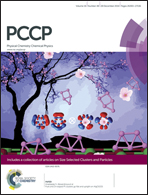Characterization of ion-irradiated poly-l-lactic acid using nano-cutting
Abstract
Effects on the mechanical strength of poly-L-lactic acid (PLLA) upon irradiation with 150 keV He+ ion were studied. Changes in the irradiated surface were investigated using a surface texture and contour measuring instrument and an atomic force microscope. Observations made with the atomic force microscope revealed that the irradiated surface subsided significantly as the fluence increased. In order to investigate the dependence on fluence of the depth of the Bragg peak for the ion implantation, the cutting strength, Σ, was analysed [F. Saito, I. Nishiyama and T. Hyodo, Mater. Lett., 2012, 66, 144–146]; this value is an indicator of the strength of a material against cutting, and is obtained from the cutting resistance. The averaged ion projected range increased from about 1.1 μm for a fluence of 1 × 1015 He+/cm2 to about 4 μm for a fluence of 1 × 1016 He+/cm2. The density of the region following irradiation was estimated using a combination of cutting resistance measurements and positron annihilation γ ray Doppler broadening measurements made with an energy-variable positron beam. The density decreased from the value of 1.27 g cm−3 to about 0.6 g cm−3 after irradiation with a fluence of 3 × 1015 He+/cm2. By considering the decrease in the density and the subsidence of the surface, it is concluded that only 30% of the original weight remained in the irradiated region after exposure to the He+ ions. Anisotropic change in the cutting resistance suggests that mechanical strength in the direction normal to the surface increased while that in the lateral direction decreased.


 Please wait while we load your content...
Please wait while we load your content...